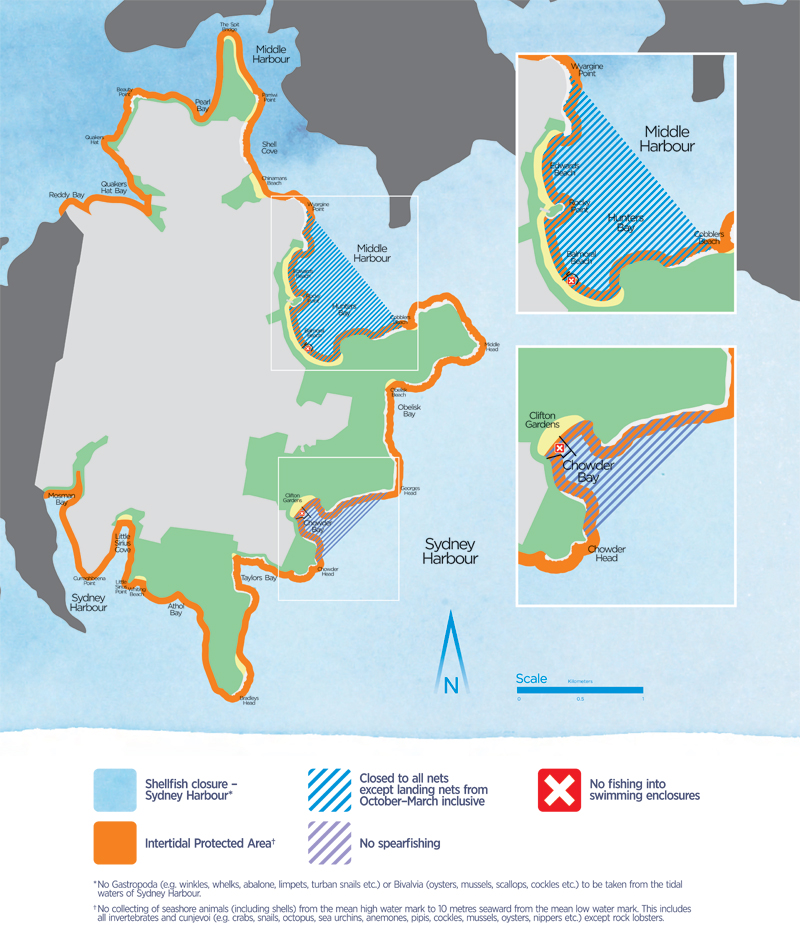- Home
- Recreation
- Fishing
Fishing
The Mosman foreshore spans 24km and has some great fishing sites. We encourage you to fish responsibly and be aware of your safety at all times.
The map below highlights the rules regarding fishing in Mosman as outlined by the NSW Department of Primary Industries (DPI).

Sydney Harbour Intertidal Protected Area
Aquatic areas surrounding Mosman are part of the Sydney Harbour Intertidal Protected Area. It includes all of the foreshores of Sydney Harbour, including the Parramatta and Lane Cove rivers. Intertidal Protected Areas cover from the mean high water mark to 10 metres seaward from the mean low water mark. They are dedicated for the protection of selected rocky habitats and intertidal species.
It is strictly prohibited to collect intertidal animals in the Sydney Harbour Intertidal Protected Area under the Fisheries Management Act 1994. This includes crabs, snails, cunjevoi, octopus, sea urchins, anemones, pipis, cockles, mussels, oysters, and nippers (saltwater yabbies).
Fishing is permitted in Intertidal Protected Areas, but bait collection is not allowed. Bait can be brought up to the quantity allowed by the NSW Department of Primary Industries bag limits.
Responsible Fishing
When you are fishing in NSW you are required by law to carry a receipt showing the payment of the NSW Recreational Fishing Fee. For more information on fees or exceptions contact DPI on 1300 369 365 or visit the website.
There are some simple actions you can take to be a responsible fisher and reduce the impact of your fishing experience on the surrounding marine environment:- Use catch and release methods when possible
- Ensure that fish are legal size and that bag limits are met. Remember fish lengths are measured from fish snout to tip of the tail. For current regulations visit the NSW DPI website
- Use environmentally friendly fishing tackle, for example lead-alternative sinkers and non-stainless steel hooks
- This will help reduce the impact snagged lines and hooks have on marine life
- Use circle hooks as these increase the chance of survival for fish that are released
- Follow advice on the recommended maximum intake of fish in Sydney Harbour to limit your exposure to dioxins
- Use the appropriate gear for the fish you are after e.g. hook size.
- Avoid using nets
- Don’t leave baited hooks and lines unattended or out of water
- Be on the lookout for birds that may take bait
Seek assistance from a local wildlife care group if you catch a bird or mammal.
Marine litter
Fishing line, hooks and bait bags can have fatal consequences to marine life and bird life if not disposed of properly. Animals can get entangled, suffocate and die.
To reduce the chance of harm to birds and marine animals:- Avoid leaving fishing lines unattended
- Dispose of lines, hooks, bait bags and other
- Rubbish responsibly in the garbage bin
- Ensure your fishing area is left clean and tidy
Guarding our ocean wildlife
A lot of us value more than just a coastal view, we love the sea itself. But the sea that we know and love is changing. Once treated as a dumping ground and considered inexhaustible, our oceans are now in crisis and need our help. The AMCS (Australian Marine Conservation Society) is Australia‘s only national charity dedicated exclusively to protecting ocean wildlife and their homes.
Marinas, boatsheds and slipways
The Office of Environment and Heritage publication Environmental Action for Marinas, Boatsheds and Slipways offers practical advice on how operators of marinas, boatsheds and slipways can make their business environmentally compliant.
For more information visit Office of Environment and Heritage or phone the Environment Line 131 555.
Last updated Tuesday 6 July 2021
Last updated Tuesday 6 July 2021